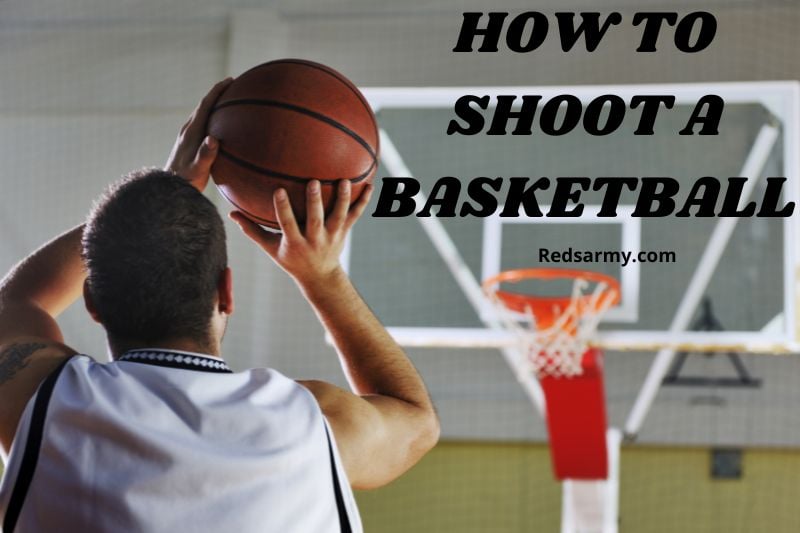Whether you're shooting for fun or aiming to take your game to the next level, nailing that perfect jump shot is essential. But with so many moving parts, it can be tough to know where to start. That's why we've put together this helpful guide on how to shoot a basketball. In it, we'll cover the basic mechanics of shooting, as well as some key drills and tips to help you improve your form.
3 Important Factors to Keep in Mind When Shooting
A great shooter needs excellent mechanics to succeed. Whether making free throws, jump shots, layups, or even slam dunks, every aspect of their body collaborates to form the basis of their shoots.  Even though the body is brought together in a single motion by these reliable mechanics, shooting a basketball effectively requires several body parts to carry out various tasks. The following three mechanical elements are crucial for correctly positioning and completing a jump shot:
Even though the body is brought together in a single motion by these reliable mechanics, shooting a basketball effectively requires several body parts to carry out various tasks. The following three mechanical elements are crucial for correctly positioning and completing a jump shot:
- Stance. How you set up your feet, which way they point, and how you support the motion of the jump shot from the ground up.
- Alignment. How your body is positioned to support a fluid jump shot motion, from your feet to your shoulders.
- Place your hands. How your non-dominant off hand (or guide hand) supports the positioning of your dominant shooting arm and shooting hand, how you position your index and middle fingers about these finger positions, and how you release the ball depending on these hand positions.
The basketball jump shot can become automatic, falling just short of the backboard at the back of the rim and going straight through the rim by combining these three separate components into one fluid action via practice and instruction. You can read more some tips help you play basketball.
How To Shoot A Basketball For Beginners
Part 1: Taking the Right Position
- Put your shooting foot very slightly ahead of your non-shooting foot. Keep your feet no more than shoulder-width apart, preferably closer together and slightly staggered. If you are right-handed, your shooting foot will be the foot that is on the same side as your shooting arm. Your shoulders, hips, and elbows should be aligned with the basket, and your feet should be turned 10 to 45 degrees to your off-side.

- Knees: Bend them a little. You can quickly lose your equilibrium if you have locked knees. Once you have the ball, flex your knees comfortably to position yourself to leap. Keep your stance in mind as you learn the shooting technique and practice. Use the stance you find most comfortable whenever possible. The idea is to become so accustomed to the stance that you don't have to deliberate before your feet move into position to unleash a powerful shot.
- If you need to take a more extended shot, turn more when jumping and maintain your shoulders back. Your turn and relaxed shoulders are what give you most of your power. If you try to throw the ball forward with strength in your arms and chest, your shot will be considerably less fluid and accurate. Practice hopping from 0 to 90 degrees without the ball to improve your turn. Make sure your shoulders are relaxed and that you are hopping forward.
Part 2: Using the Proper Ball Holder
- Drop the ball to your thigh or waist. Your shooting eye should draw a straight line to the hoop with the ball.
- Position your elbow so it's in line with your shoulder, not directly under the ball. Learn to place the ball in the exact location each time you prepare to take a shot. Dip the ball when it is passed to your thigh or waist. You don't need to dip if you catch a bounce pass, another low pass, or are shooting off the dribble because you are already doing so.
Additionally, if you are right-handed, hold the back of the ball firmly in place with your right hand while maintaining your left hand on the side of the line. Shoot with the same hand that you write with. Your second hand is only for holding the guide. Do the opposite if you are a left-handed person. 
- Learn how to hold a basketball when shooting. The shooting hand, which is used to launch the ball, should be positioned so that your fingertips are parallel to the seams in the ball. To guide the shot, place your non-shooting hand on the side of the ball. When you're getting ready to shoot, your palm may or may not be in contact with the ball; you may be controlling it with your fingers and thumb.
Give the ball enough room between your hand and the ball so it can easily slide off your fingertips. Your finger pads should rest the ball there. To better control the ball, spread your fingers widely.
Part 3: Executing the Shot
- Find the target. You must look at the net if you want the ball to go into the net. Look at the backboard area you want to hit if you intend to bank the ball off it. Your eyes play a huge role in making a good basketball shot. Following the ball's flight after release is a widespread practice among great NBA shooters, but you can also keep your eyes on the rim.
- Knees should be straight, then jump. Jump upward while your shooting hand propels the ball, and your shoulders bend back to use your legs to assist in ball propulsion. To take the shot, move your arms, body, and legs unison.

- When you shoot, lean back slightly and ensure your shoulders are relaxed. There will be a lot of tension in your neck and shoulders if your feet land in the same place they started. Your ball will have more arc if you jump forward.
As you jump, avoid leaning forward. If your body is balanced, you should jump naturally to release tension and ensure a balanced shot.
- Your shooting hand should push the ball upward. Move the ball smoothly from your dip to eye level as your hips lift and you begin your jumping motion. It needs to all happen in one fluid motion. You should turn between 20 and 90 degrees in the direction of your off-hand as your hips rise and your elbow rises with the ball.
Keep the ball in front of you and away from the side. It should be fired forward and fluidly. Your non-shooting hand's only purpose is to direct the ball and maintain its stability while your shooting hand fires. 
- Let go of the ball. Release the ball with your shooting hand pointed towards the basket as soon as you are about to jump. Instead of the ball traveling in a straight line toward the hoop, push your wrist and straighten your elbow. Your guiding hand should travel to lightly touch your shooting arm just below the wrist as you release the ball.
The ball will roll off your fingertips and toward the goal. By observing the backspin, you can determine whether you shot it correctly; if the basketball spins in symmetrical lines, you positioned the ball perfectly.
- Carry through. This is a crucial step in shooting a basketball. A shot taken from the wrist won't be nearly as accurate without following through. Your shooting hand will appear like a swan when the shot is successful; your arm will be elegantly arched toward the basket, your writing will be loosely cocked downward, and your fingers will be pointing toward the hoop. We refer to this as follow-through.
Part 4: Developing Your Method
- Create muscle memory. Because basketball is such a fast-paced game, you won't have time to consider your shooting mechanics when the clock runs out, and your opponents attempt to steal the ball from you. To make taking a shot feel natural, you should practice shooting as much as possible. This includes everything from the stance and grip to the jump and release.
Practice from various perspectives. Use the same form every time you shoot, whether you're farther away from the hoop or shooting from different angles and distances around the rim. You should turn more and jump further ahead for a more extended shot instead of a shorter one. 
- Work on your free throws. The free throw line, which is 15 feet (4.6 meters) from the basket, is where foul shots, also known as free throws, are made. It's an excellent distance to practice from, and because it's behind the hoop and in front of the backboard, the ball will typically bounce back to you, reducing the need for frequent chasing.
- Use the backboard to begin. The backboard can be a helpful tool when taking shots close to the basket. Depending on where you are on the court, you will need to bank the ball off the backboard. Aim for the top right corner of the square on the backboard if you are on the right side of the court. You should aim for the top left corner of the square if you are standing on the court's left side.
When shooting layups, which are done off the dribble rather than from a standing stance, use the backboard.
- Play a game as you practice. Once you feel confident shooting alone, gather your friends for a basketball scrimmage or sign up for a league to play some games. Since you must catch passes, avoid steals, and be aware of the strategy your coach and the other players anticipate you to adopt, shooting under pressure in a game is a little more complicated than doing it alone in your backyard. However, if you work on your form and create strong muscle memory, you'll soon be piling up the points.

Why it's Important to Improve Your Shooting
Are you unsure if you want to take the necessary time to improve your shooting? Here are some reasons it's crucial that you...
1. Increases Your Chances of Scoring
Your ability to shoot well will enhance your scoring across the board. You'll be able to score much more quickly than before by driving to the basket and making more shots from beyond the paint. "What's up? " When you're a terrific shooter, the defense must play you close on and off the ball to stop you from making an outside shot. If you have the basketball, this gives the defender much less time to react to a cut to the rim or a drive to the basket.
2. increases the Chances for your Teammate to Score
Great shooters can contribute to a team's score without touching the basketball. Your team's offense will benefit from your presence on the court by having a scoring threat from outside the arc. It is challenging for a shooter's defender to play help defense on the other offensive players since they must play close to them to block the rapid shot. As a result, there will be more excellent interior room for finishing at the rim, open cutters, open driving lanes, etc. 
3. Scoreboard Points Increase
Putting points on the scoreboard is necessary if you want to win more basketball games. And better shooting makes it happen! A player will be more effective than one who hits 50% of their two-point attempts if they can convert 35% of their three-point attempts. This is why teams at all levels attempt more three-pointers as players improve their shooting.
4. Shows You Improve Your Game
There is one rule that will never change when it comes to shooting. Not all shooters are born. They are created. It is hard to develop into a great shooter without an unwavering commitment to raising your game to a championship level. All recruiters and coaches are aware of this. Read more How To Get Recruited For College Basketball? Being a great shooter demonstrates to everyone watching that you pay close attention to detail, put in a lot of effort, and are disciplined. Recruiters are searching for all of these qualities. 
5 Errors in Basketball Shooting Form (and how to fix them)
Here are the five most common shooting technique errors I observe in players of all skill levels. Many of these are easy to correct once you know what to look for.
1. Not Using Enough Arc When Shooting
Being a superb shooter is difficult if you have a flat shot. When you make a flatter shot, less of the hoop must be penetrated by the basketball. In 99 percent of instances, this happens due to a player pushing the ball out towards the hoop from their chest instead of shooting it up into the air. To prevent this, ensure players are wrinkling their wrists, have their elbows under the ball, and finish their elbows next to their eyebrows while releasing the shot. 
2. Using the Thumb of the Balance Hand to Push
A one-handed shot is the standard shooting motion in basketball. The dominant hand should shoot the basketball with 100% accuracy after the balance hand stabilizes it up until the point of release. However, it's not always the case. Many athletes develop the undesirable habit of giving the shot extra power by utilizing the thumb on their balancing hand. When a player is young and lacks the strength to shoot one-handedly traditionally, this is important. Instead, they use two hands to shoot to compensate for their lack of power. Players must transition away from the two-handed shot and learn to shoot without using the thumb of their balance hand as they get older and more robust.
3. Not dipping the Ball in the Hoop
In basketball history, almost every great shooter sinks the ball.
- Curry squats down.
- Ray Allen twitches.
- Dive by Dirk Nowitzki.
- Stephen Nash sways.
- Dip for Kevin Durant.
You see what I mean... Why are so many coaches telling players not to dip when they catch the basketball? (Yes, I experienced this.) The importance of dipping the basketball may be boiled down to three basic factors. To guarantee a reliable starting place (shot pocket). For the shot's rhythm. To avoid getting the upper body overly tense. Basketball players: Dip the ball.
4. Players Are Encouraged to Follow Their Shot
One of the worst advice a coach can give to one of his players is to "follow your shot." A player's shot will suffer from this in two ways.
- Their shooting technique will be ruined.
The rhythm of a jump shot will naturally cause the shooter's upper body to move back and their lower body to move a little forward. They shift away from the rim as a result. Players will be compelled to shoot with poor technique to ensure they can rush in and compete for the rebound.
- It will cause them to think incorrectly.
A player is informed that they are likely to miss when told to follow their shot. I believe we can all agree that having this attitude before taking a shot is horrible. Never follow your shot until you are confident it is off (players can always feel the terrible ones). Players should focus all of their attention every time they shoot on executing the whole shot sequence with the most acceptable form possible. 
5. Not Spreading Fingers Wide Enough
Another crucial teaching element is ensuring players shoot comfortably wide on the basketball with their fingers. The fingers of many young athletes are too close together when they catch and shoot. Players will have less control when they make a shot the closer their fingers are together. When your squad is practicing form shooting, this is the ideal opportunity to bring up the subject. Check to see if everyone is spreading their fingers widely enough by having each player hold the basketball in their shooting pocket.
Tips from Steph Curry to Improve Your Shooting
Knowing how to shoot is one thing; doing it is quite another. Curry offers advice on how to use practice to apply your expertise on the court. Basketball shooting exercises and drills can help you build muscle memory, which will help you shoot naturally every time you get the ball up from the free throw line to the three-point line. Here are some of Curry's pointers on shooting with perfect form.
- Practice your form in front of a mirror without a ball. Pay attention to how your feet are placed and your lower body is aligned. Also, load your hips, bring your shooting hand up through your brow in a clean line, and release with an elbow above your eye.
- Walk around the basketball court for 15 minutes focusing on the rim. Know the number of hooks on the rim and how many of them are facing you at various angles and distances. Practice rushing to an arbitrary location on the floor, stopping as soon as possible using your eyes to locate the rim hooks.

- On the ball, practice your hand alignment. To sense the ball's center, place your index finger from your shooting hand on the air valve of the basketball, much like Stephen did. Take 10 shots by locating the air valve while standing just a few feet away from the basket. Then, without looking for the air valve, take 10 more by just placing your hand in the ball's middle.
Basketball drills can help you establish solid shooting habits and all-around basketball skills by regularly performing these motions. With dedication, solid dribbling, and hard effort, you can become one of the top shooters on the floor with a swish and shooting percentage you can be proud of using this basketball shooting method and form.
Special Instructions for Basketball Coaches
We are to blame if a young player uses the poor shooting form. Not any particular coach, but all of us together. Players develop certain shooting habits early. Therefore we can't expect children from 5 to 12 to be proficient shooters. Our coaches must ensure that our players are shooting with the excellent technique by teaching them proper form and practicing shooting technique drills. I once published an article outlining the two simple steps necessary to become a great shooter.
1. (Coach's responsibility) Understand the mechanics
Learning proper way to shoot a basketball is the first step to becoming a great shooter. The coach must learn excellent shooting techniques and impart them to their athletes. It's one of our most crucial responsibilities to help athletes improve their stroke. 
2. Numerous clever repetitions (player obligation)
The onus of carrying out the second step rests on each player's shoulders. Investing the time necessary to take the number of shots necessary to become a great shooter (I recommend 1,500 makes a week). Simply put, players haven't enough time during practice to set up many shots. These makes must be made primarily on the player's own time.
FAQs: Best Way To Shoot A Basketball
Should I shoot the 1-2 or a hop?
Players must master both shooting offs. I vehemently oppose coaches who mandate that their athletes only use the hop or the 1-2 step. There are moments during a game when it is better to use the hop and others during a game where it is better to use the 1-2 step. Players will eventually form preferences, and I suggest letting them decide for themselves. However, athletes must be able to shoot off of both.
How many shots per week should I take?
Depending on the degree of shooter you want to become, this is the number of shots I advise you to take per week.
- A skilled shooter makes 1,500 shots each week.
- A great shooter makes 1,000 shots each week.
- Poor shooter = 500 attempts made each week.
This may seem like a small total to some, but I can assure you that it won't be simple if you attempt to hit every target while moving at game speed. All athletes must schedule a time to go to the gym and practice their shots, given the number of distractions we have nowadays. 
When shooting, where on the rim should I look?
There isn't a single aim that all players ought to be focusing towards.
Should the middle or index finger make the final contact with the basketball?
Another one of those questions without a single "correct" response is this one. Although many excellent shooting trainers have different views, I have always taught the fork (index and middle release at the moment). The results of a survey I conducted on Twitter (follow me!) with 1,115 votes revealed that 49% of respondents thought the middle finger should be the last to touch the basketball. This proves that all finger releases should be checked by players, even if I am aware of very few shooting coaches that advocate for it. Any one of the three can, in my opinion.
Why is backspin such a crucial factor?
Because it produces a "soft" shot, backspin is crucial while shooting. Basketballs are likelier to bounce off the rim and land through the hoop when shots are soft (or touched). Without a backspin, a shot will hit the rim, bounce away, and have very little chance of going in for a score.
Which way ought my feet to be facing?
Short answer: Feet should turn slightly. This prevents athletes from straining their chest while opening their shoulder and getting their elbow under the basketball.
Conclusion
The most important thing to remember when shooting a basketball is to follow through with your shot. This means that you should extend your arm and snap your wrists as you release the ball, keeping your fingers pointed towards the basket. Remember to keep your eyes on the rim and use your body to create balance and power. With practice, you'll be able to perfect basketball shooting technique and make baskets with ease.





